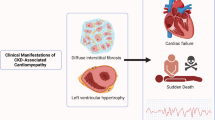Abstract
The clinician, Franz Volhard, and the pathologist, Theodor Fahr, worked closely together in Mannheim from 1909 until 1915 and introduced a novel classification of renal diseases. In the monograph entitled ‘Die Bright’sche Nierenkrankheit, Klinik, Pathologie und Atlas’ (1914) they differentiated between degenerative (nephroses), inflammatory (nephritides) and arteriosclerotic (scleroses) diseases. Nephrosclerosis was divided into the benign and malignant form, of which the latter stood the test of time as a new disease entity. Fahr further divided benign nephrosclerosis into the compensated and decompensated form – depending on the presence or absence of glomerular injury. In the pathogenesis of malignant nephrosclerosis, Volhard stressed the decisive role of severe blood pressure elevation, while Fahr postulated an inflammatory mechanism, a concept later confirmed by Adalbert Bohle for at least a minority of patients. A very far reaching concept of Franz Volhard was his idea that pale (renal) hypertension results from a pressor substance released from ischaemic kidney(s) contributing – via a vicious circle – to a further rise in blood pressure with subsequent renovascular injury and aggravation of hypertension. This hypothesis was supported in 1930 by initial experiments of his collaborator, Hartwich (demonstrating in dogs a mild rise in blood pressure after ligation of branches of the renal artery) and definitively proven by Goldblatt (1934) in dogs by induction of severe and persistent hypertension after clamping of both renal arteries. The consequent detection of the renin angiotensin system was the final confirmation of Volhard’s postulated renal pressor substance. In the pathogenesis of red (essential) hypertension, Volhard stressed the role of hereditary factors, age, obesity and potentially of severe alcoholism. He emphasised a premature reduction of vascular distensibility (due to elastosis of the prearterioles), a high cardiac output as well as a dampening of baroceptor function. Additionally, Volhard made crucial advances in cardiology and pneumology.
This is a preview of subscription content, access via your institution
Access options
Subscribe to this journal
Receive 12 digital issues and online access to articles
$119.00 per year
only $9.92 per issue
Buy this article
- Purchase on Springer Link
- Instant access to full article PDF
Prices may be subject to local taxes which are calculated during checkout
Similar content being viewed by others
Author information
Authors and Affiliations
Rights and permissions
About this article
Cite this article
Heidland, A., Gerabek, W. & Sebekova, K. Franz Volhard and Theodor Fahr: achievements and controversies in their research in renal disease and hypertension. J Hum Hypertens 15, 5–16 (2001). https://doi.org/10.1038/sj.jhh.1001130
Received:
Accepted:
Published:
Issue Date:
DOI: https://doi.org/10.1038/sj.jhh.1001130
Keywords
This article is cited by
-
Relationship between diurnal blood pressure and renal histopathological changes in white coat hypertension
Journal of Nephrology (2017)
-
The Aging Kidney: A Review – Part I
International Urology and Nephrology (2005)



